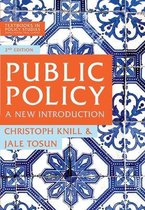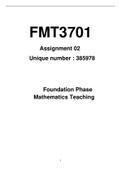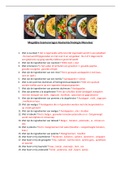CH. 3 CENTRAL INSTITUTIONS AND ACTORS
- Actors: individuals, corporations or other collective entities who possess policy
preferences and the desire to realise them through their participation in the policy-
making process.
- Institutions determine the extent to which actors can transform their preferences into
public policy.
NATIONAL INSTITUTIONS: DEFINING THE RULES OF THE POLITICAL GAME
Constitutions and Constitutional Courts
- Constitution: a set of fundamental principles and formal rules according to which a
state is governed.
- It also sets a foundation for legislative procedures and limits the exercise of
government power in the name of individual rights.
- By making it hard for these rules to be changed, politicians are bound by their own
decisions, preventing governmental encroachment on the rights of individuals and
ensures the constitution cannot be modified in order to serve the interests of a
particular government (e.g. changing rules of re-election).
- A state can be organised according to:
- Unitarism: sovereignty is concentrated at the level of a single central
government.
- Federalism: sovereignty is shared across several levels of government.
- Some countries do not have a constitutional court to protect the constitution, so they
instead detect constitutional violations through:
- Abstract reviews
- These are made before legislation enters into force. It checks that a
legislative bill is compatible with the constitution.
- Concrete reviews
- These are carried out in accordance with procedures for ordinary
litigation and are initiated by ordinary judges. The judges determine
who wins or loses the case and if there are reasonable doubts about
the constitutionality of the matter in question.
- Constitutional complaints
- Individuals who can prove their constitutionally guaranteed rights have
been violated by a public authority can file a constitutional complaint.
Division of Powers
- Trias politica: division of power through three branches of government (executive,
legislature and judiciary) and keep each other in check so that power is not misused.
- Executive - in charge of implementing public policy and has the authority to
administer the bureaucracy.
- Legislature - are in charge of making legislation, the head of government has
some executive powers but has to answer to the legislature.
- Judiciary - various levels of courts that interpret and apply the law and resolve
disputes emerging amongst private and public actors.
, - The judiciary is independent of the other branches of government.
- The horizontal division of power is in some political systems complemented by a
vertical division of power between the state as a whole and its geographically defined
units (federalism).
- Federalism - represents mutual control between different elements of government
and may produce desirable public policies. The variety of different political arenas in
federal systems might favour policy innovation and learning.
- Unitarism - change monetary policies more often and radically, moving quickly from
high to low inflation, vice versa.
Case study: Legislature in South Africa
- Parliament consists of two houses:
- The national assembly
- Lower house
- Members are directly elected
- Number of seats that a political party has is in proportion to the
number of votes it received in an election
- The national council of provinces
- Upper house
- 10 delegates for each province of the republic so all are equally
represented.
- Elections are indirect - citizens vote for provincial legislatures, and
each legislature nominates a delegation of ten members.
- The council represents the governments of provinces rather than
directly representing people. It proposes, considers, amends, passes
and rejects legislative bills.
Electoral Institutions and Party Systems
- Elections - legitimise policy-makers and determine who is going to have the greatest
political influence for a certain period of time.
- Electoral institutions - include provisions about who can be elected, specifications of
election types, the time that may sit between elections and issues of suffrage and
compulsory voting.
- Electoral systems - define how votes are transformed into parliamentary seats.
- Majoritarian system: based on single-member constituencies, the strongest
party in each constituency wins the seat.
- Australia - voters can rank the different candidates, with their order
being taken into account if there is no clear overall winner.
- France - two-round system where if no candidate wins a majority of
votes, the 2 top ranked participate in a second election round.
- Proportional system: multimember constituencies, seats are shared amongst
parties in proportion to the share of votes they have received.
There are four types of party system:
- Dominant-party system
- Actors: individuals, corporations or other collective entities who possess policy
preferences and the desire to realise them through their participation in the policy-
making process.
- Institutions determine the extent to which actors can transform their preferences into
public policy.
NATIONAL INSTITUTIONS: DEFINING THE RULES OF THE POLITICAL GAME
Constitutions and Constitutional Courts
- Constitution: a set of fundamental principles and formal rules according to which a
state is governed.
- It also sets a foundation for legislative procedures and limits the exercise of
government power in the name of individual rights.
- By making it hard for these rules to be changed, politicians are bound by their own
decisions, preventing governmental encroachment on the rights of individuals and
ensures the constitution cannot be modified in order to serve the interests of a
particular government (e.g. changing rules of re-election).
- A state can be organised according to:
- Unitarism: sovereignty is concentrated at the level of a single central
government.
- Federalism: sovereignty is shared across several levels of government.
- Some countries do not have a constitutional court to protect the constitution, so they
instead detect constitutional violations through:
- Abstract reviews
- These are made before legislation enters into force. It checks that a
legislative bill is compatible with the constitution.
- Concrete reviews
- These are carried out in accordance with procedures for ordinary
litigation and are initiated by ordinary judges. The judges determine
who wins or loses the case and if there are reasonable doubts about
the constitutionality of the matter in question.
- Constitutional complaints
- Individuals who can prove their constitutionally guaranteed rights have
been violated by a public authority can file a constitutional complaint.
Division of Powers
- Trias politica: division of power through three branches of government (executive,
legislature and judiciary) and keep each other in check so that power is not misused.
- Executive - in charge of implementing public policy and has the authority to
administer the bureaucracy.
- Legislature - are in charge of making legislation, the head of government has
some executive powers but has to answer to the legislature.
- Judiciary - various levels of courts that interpret and apply the law and resolve
disputes emerging amongst private and public actors.
, - The judiciary is independent of the other branches of government.
- The horizontal division of power is in some political systems complemented by a
vertical division of power between the state as a whole and its geographically defined
units (federalism).
- Federalism - represents mutual control between different elements of government
and may produce desirable public policies. The variety of different political arenas in
federal systems might favour policy innovation and learning.
- Unitarism - change monetary policies more often and radically, moving quickly from
high to low inflation, vice versa.
Case study: Legislature in South Africa
- Parliament consists of two houses:
- The national assembly
- Lower house
- Members are directly elected
- Number of seats that a political party has is in proportion to the
number of votes it received in an election
- The national council of provinces
- Upper house
- 10 delegates for each province of the republic so all are equally
represented.
- Elections are indirect - citizens vote for provincial legislatures, and
each legislature nominates a delegation of ten members.
- The council represents the governments of provinces rather than
directly representing people. It proposes, considers, amends, passes
and rejects legislative bills.
Electoral Institutions and Party Systems
- Elections - legitimise policy-makers and determine who is going to have the greatest
political influence for a certain period of time.
- Electoral institutions - include provisions about who can be elected, specifications of
election types, the time that may sit between elections and issues of suffrage and
compulsory voting.
- Electoral systems - define how votes are transformed into parliamentary seats.
- Majoritarian system: based on single-member constituencies, the strongest
party in each constituency wins the seat.
- Australia - voters can rank the different candidates, with their order
being taken into account if there is no clear overall winner.
- France - two-round system where if no candidate wins a majority of
votes, the 2 top ranked participate in a second election round.
- Proportional system: multimember constituencies, seats are shared amongst
parties in proportion to the share of votes they have received.
There are four types of party system:
- Dominant-party system












